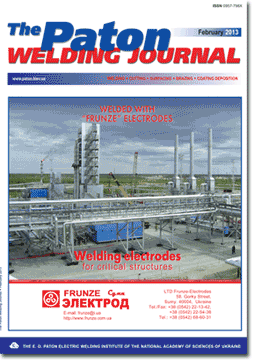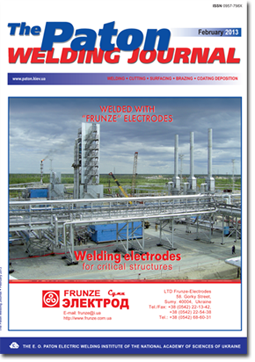
The Paton Welding Journal, 2013, #2, 8-12 pages
1E.O. Paton Electric Welding Institute, NASU, Kiev, Ukraine
2Frantsevich Institute for Problems of Materials Science, Kiev, Ukraine
Abstract
Silicon oxide is included into composition of fluxes for welding of carbon and low-alloy steels. To predict the metallurgical and welding-technological properties of fluxes, it is important to know their activity in slag melt. The aim of the present work is to develop the methods of in-process evaluation of activity (effective concentration) of silicon oxide SiO2 in slag melts and to define the methods of its control. The design of unique electrolytic sensor has been developed. The application of alloy, containing 5wt.%Si as the second electrode allowed increasing the heat resistance of the sensor up to 1500 °C. Using the designed sensor, the procedure was suggested for determination of SiO2 activity in slag melts by using the method of electromotive forces, which guarantees the accuracy in measurement of electromotive forces within 1-2mV ranges. This procedure can be applied in metallurgy directly in the melting process, as well as in the development of welding consumables. It was found that increase in MgO content in slag melt of MgO-Al2O3-SiO2-CaF2 system causes the reduction in silicon oxide activity, that can be explained by the formation of refractory and thermodynamically stable silicates and aluminates of magnesium. The effect of additions (1 wt.%) of metals on the SiO2 activity in melts of MgO-Al2O3-SiO2-CaF2 system was determined. The feasibility of control of thermodynamic activity of silicon oxide in slags in welding and, respectively, the processes of silicon reduction and formation of non-metallic inclusions in welds is shown. 5Ref., 3 Tables, 1 Figure.
Keywords: arc welding, high-strength steels, slag melts, thermodynamic properties, activity of SiO2, electrolytic sensor, methods of control
Received: 17.12.12
Published: 28.02.13
References
1. Sudavtsova, V.S., Makara, V.A., Galinich, V.I. (2005) Thermodynamics of metallurgical and welding melts. Pt 1: Iron- and aluminium-based alloys. Kiev: Logos.
2. Taylor, J.R., Dinsdale, A.T. (1990) Thermodynamic and phase diagram data for the CaO-SiO2 system. Calphad, 14(1), 71-88.
3. Goncharov, I.A., Sokolsky, V.E., Davidenko, A.O. et al. (2012) Formation of spinel in melt of the MgO-Al2O3-SiO2-CaF2 system agglomerated welding flux and its effect on viscosity of slag. The Paton Welding J., 12, 18-25.
4. (1979) Thermodynamic properties of individual materials: Refer. Book. Ed. by V.P. Glushko. Vol.2, Book 2. Moscow: Nauka.
5. Podgaetsky, V.V., Kuzmenko, V.G. (1988) Welding slags. Kiev: Naukova Dumka.
AS = «Automatic Welding» - 6 issues per year;
TPWJ = «PATON WELDING JOURNAL» - 12 issues per year;
SEM = «Electrometallurgy Today» - 4 issues per year;
TDNK = «Technical Diagnostics and Non-Destructive Testing» - 4 issues per year.
| 2013 №02 (01) | 2013 №02 (03) |

The Paton Welding Journal, 2013, #2, 8-12 pages
METHODS OF CONTROL OF SILICON OXIDE ACTIVITY IN SLAG MELTS
I.A. GONCHAROV1, V.I. GALINICH1, D.D. MISHCHENKO1, R.N. SHEVCHUK1, A.N. DUCHENKO1 and V.S. SUDAVTSOVA2
1E.O. Paton Electric Welding Institute, NASU, Kiev, Ukraine
2Frantsevich Institute for Problems of Materials Science, Kiev, Ukraine
Abstract
Silicon oxide is included into composition of fluxes for welding of carbon and low-alloy steels. To predict the metallurgical and welding-technological properties of fluxes, it is important to know their activity in slag melt. The aim of the present work is to develop the methods of in-process evaluation of activity (effective concentration) of silicon oxide SiO2 in slag melts and to define the methods of its control. The design of unique electrolytic sensor has been developed. The application of alloy, containing 5wt.%Si as the second electrode allowed increasing the heat resistance of the sensor up to 1500 °C. Using the designed sensor, the procedure was suggested for determination of SiO2 activity in slag melts by using the method of electromotive forces, which guarantees the accuracy in measurement of electromotive forces within 1-2mV ranges. This procedure can be applied in metallurgy directly in the melting process, as well as in the development of welding consumables. It was found that increase in MgO content in slag melt of MgO-Al2O3-SiO2-CaF2 system causes the reduction in silicon oxide activity, that can be explained by the formation of refractory and thermodynamically stable silicates and aluminates of magnesium. The effect of additions (1 wt.%) of metals on the SiO2 activity in melts of MgO-Al2O3-SiO2-CaF2 system was determined. The feasibility of control of thermodynamic activity of silicon oxide in slags in welding and, respectively, the processes of silicon reduction and formation of non-metallic inclusions in welds is shown. 5Ref., 3 Tables, 1 Figure.
Keywords: arc welding, high-strength steels, slag melts, thermodynamic properties, activity of SiO2, electrolytic sensor, methods of control
Received: 17.12.12
Published: 28.02.13
References
1. Sudavtsova, V.S., Makara, V.A., Galinich, V.I. (2005) Thermodynamics of metallurgical and welding melts. Pt 1: Iron- and aluminium-based alloys. Kiev: Logos.
2. Taylor, J.R., Dinsdale, A.T. (1990) Thermodynamic and phase diagram data for the CaO-SiO2 system. Calphad, 14(1), 71-88.
3. Goncharov, I.A., Sokolsky, V.E., Davidenko, A.O. et al. (2012) Formation of spinel in melt of the MgO-Al2O3-SiO2-CaF2 system agglomerated welding flux and its effect on viscosity of slag. The Paton Welding J., 12, 18-25.
4. (1979) Thermodynamic properties of individual materials: Refer. Book. Ed. by V.P. Glushko. Vol.2, Book 2. Moscow: Nauka.
5. Podgaetsky, V.V., Kuzmenko, V.G. (1988) Welding slags. Kiev: Naukova Dumka.
The cost of subscription/purchase order journals or individual articles
| Journal/Currency | Annual Set | 1 issue printed |
1 issue |
one article |
| AS/UAH | 1800 UAH | 300 UAH | 300 UAH | 150 UAH |
| AS/USD | 192 $ | 32 $ | 26 $ | 16 $ |
| AS/EUR | 180 € | 30 € | 25 € | 15 € |
| TPWJ/UAH | 7200 UAH | 600 UAH | 600 UAH | 280 UAH |
| TPWJ/USD | 384 $ | 32 $ | 26 $ | 16 $ |
| TPWJ/EUR | 360 € | 30 € | 25 € | 15 € |
| SEM/UAH | 1200 UAH | 300 UAH | 300 UAH | 150 UAH |
| SEM/USD | 128 $ | 32 $ | 26 $ | 16 $ |
| SEM/EUR | 120 € | 30 € | 25 € | 15 € |
| TDNK/UAH | 1200 UAH | 300 UAH | 300 UAH | 150 UAH |
| TDNK/USD | 128 $ | 32 $ | 26 $ | 16 $ |
| TDNK/EUR | 120 € | 30 € | 25 € | 15 € |
AS = «Automatic Welding» - 6 issues per year;
TPWJ = «PATON WELDING JOURNAL» - 12 issues per year;
SEM = «Electrometallurgy Today» - 4 issues per year;
TDNK = «Technical Diagnostics and Non-Destructive Testing» - 4 issues per year.

